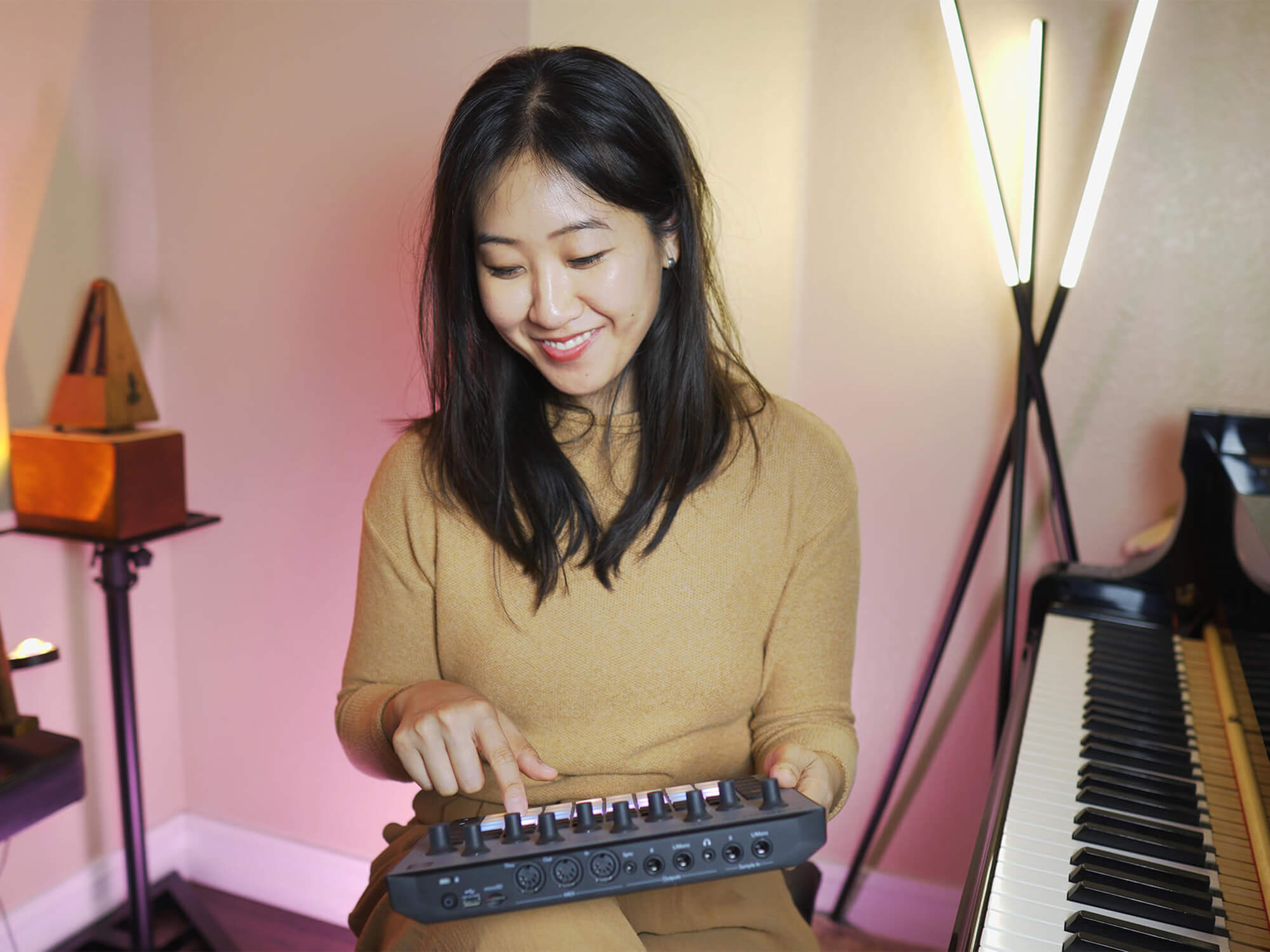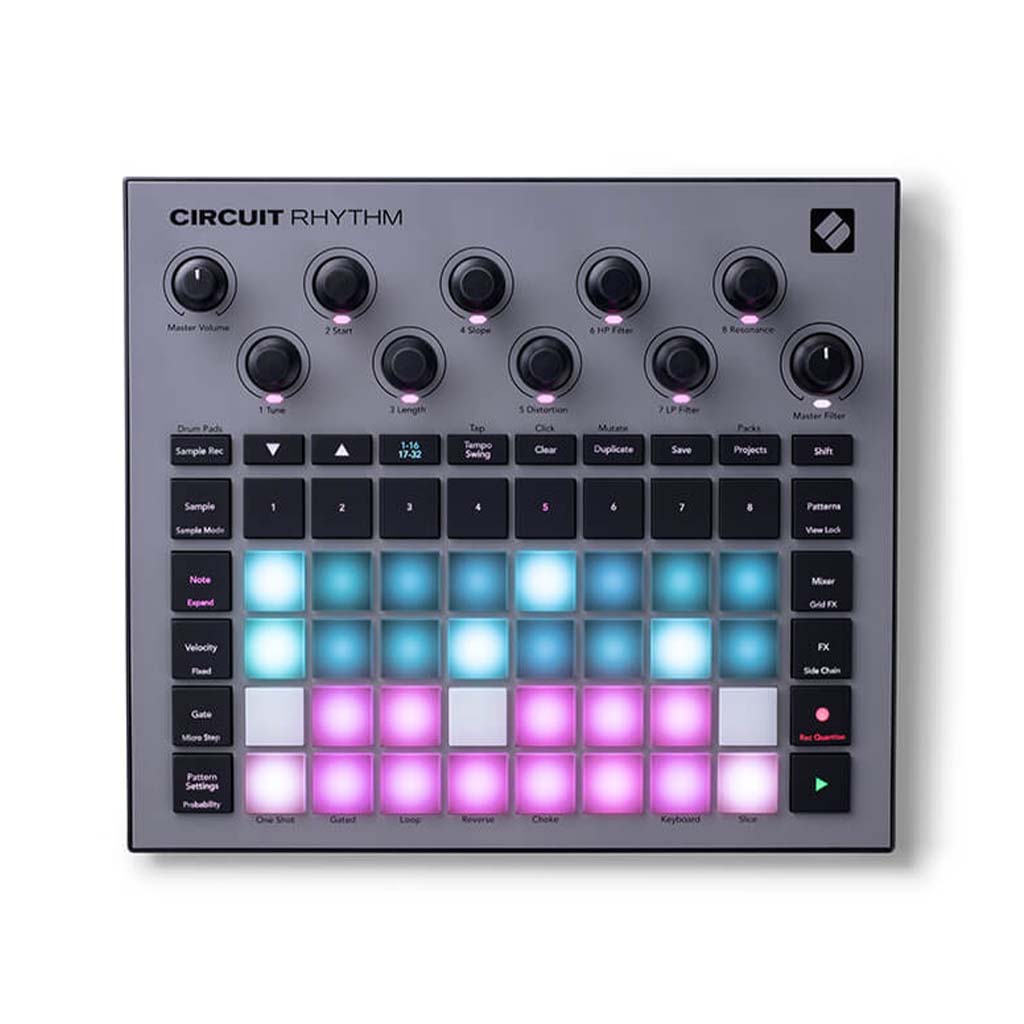How Nahre Sol brought beatmaking into her classically-trained world: “I began to understand the appeal of sampling”
The classically-trained musician discusses her experiments with sampling, learning to improvise, and life as a content creator.

Image: Focusrite/Nahre Sol
On 1 June 2024, Nahre Sol published a video to her YouTube channel, in which she performs Rick Astley’s Never Gonna Give You Up in a variety of piano styles, ranging from French Impressionism to Japanese anime. It is, quite possibly, the most sophisticated Rickroll in existence.
The video marks the seventh anniversary of Sol’s YouTube channel – now 730,000 subscribers strong – and encapsulates what makes the pianist/composer one of the best music creators on the platform: virtuosity, a sense of humour, and a willingness to experiment with genres, styles, and, now, technology.
Earlier this year, the Juilliard School-trained classical musician tried her hand at creating beats with a sampler. “I’ve been interested in sampling for a while, but never really dedicated the time to learn the ins and outs of it.” Sol tells me, “I come from a classical music background, so I have a tendency to be a bit intimidated by technology. It took a while, since that spark of interest, to get to a point where I actually grabbed a device [and began experimenting].”
The device she chose was Novation’s Circuit Rhythm, a standalone sampler and drum machine that “stood out because it seemed more on the simpler side of things and was very tactile. I’m a pianist, so I really like [the idea of] something where I could use touch. I turned it into a mini project and thought, ‘Let me give myself a week and just learn about it’. It turned into a little more than that.”

The result is what she calls “a mini-documentary”, in which we see Sol discover this technology and make it fit into her classically-trained world. “The interesting thing about learning a new device is that it has its quirks; there is a reason behind why the buttons are [a certain] way, and how things are labelled. Since I’m not used to thinking about music in that way, it took me time to really embrace why [a particular] function was even there.
Once she got the hang of it, Sol flew past the beginner level and decided to create her own samples, instead of using ones from a pack. She says, “There’s something really cool about figuring out how to make a kick drum sound from, say, a chair that you sat on.” Or miscellanea from a hotel room, as was the case here. Chopsticks, a glass, a water bottle, even a tissue box, were all fair game.“I started really liking those sounds because they’re personal. This is where I began to understand the appeal of going out of your way to sample something.
“Also, because my music is not quite classical, not quite jazz, or electronic, I’ve always struggled with [sounds from] sample packs that I’m just not used to using as part of my palette,” Sol continues. “I was really attracted to some of the higher-pitched percussion sounds [I recorded] and that’s why as soon as I compiled some, I thought, ‘I can do something with these sounds’.”

The piece she finally created “captures the feeling of being lost in a contemplative mood while cooking”. Watching her play live piano and seamlessly integrate the hotel room samples into the performance using the Circuit Rhythm, makes one wonder why more classical musicians don’t embrace technology like this. “I don’t know the answer. The closest I can get is that, in general, because the classical music world is preoccupied with the history (and maybe the philosophy) of all this music that was written hundreds of years ago, and it requires so much brainpower and dedication to refine your technique, there just isn’t much space to roam.”
Classical music is also not big on frequent updates – either in terms of instruments or technique – leading to what Sol describes as “a cultural distance” from new technology. “What comes from that is this automatic thinking: ‘That’s not for me because that’s a different world.’”
That belief could be true, Sol tells me, if classical musicians were still making music “in the way of the 1800s or 1900s.” But this is no longer the case and, as a result, she views technology as an ideal modern companion — especially with the musical ideas and techniques employed by contemporary concert music composers.
I’ve always felt a lack of meaning or creativity when I tried to come to a music project with an attitude of, ‘Let’s be great; let’s do something important.’ It’s really not about that.
The lack of improvisation in classical music is another reason why more musicians don’t make the leap, Sol says. The musician likens it to someone who is trained to speak English by learning Shakespearean monologues. “You’re an expert with language because you have all of this memorised, but you’ve never really sat down and learnt how to have a simple conversation with someone. You have to unravel some of that.”
The first step, according to Sol, is to start small. “I just leaned into anything that was fun, new, and a little out-of-left-field, like the Circuit Rhythm, which was very improvisatory. Let’s play with it!”
Another obstacle to embracing new technology is the fear of getting things wrong, which can pose a threat to the very identity of a musician. Sol agrees, “I’m not so precious about maintaining a certain image; I’m not putting pressure on myself to follow in the footsteps of a certain lineage or create something so epic or profound. Music-making is very much a part of living; it’s always personal and there’s always significance [to it], whether I just have a little idea and put it down, or if it’s a project that I really care about and I’m writing for six months.
“I view all of these projects as [being] part of the human experience. I’ve always felt a lack of meaning or creativity when I tried to come to a music project with an attitude of, ‘Let’s be great; let’s do something important.’ It’s really not about that.”
This explains her willingness to step into the world of content creation, which is almost a necessity for anyone trying to be a musician today. Sol says, “It’s exciting because you can be in touch with people that might not [otherwise come across your work]. Also, you have the autonomy to create your own projects, share them, and learn from each other. Those are the pros.”
“The cons are that [creating content] requires a different muscle. It also requires so much time and energy – you can’t just add it on top of your life – and it essentially takes away from what musicians want to do, which is make music, so it is a give and take.
Sol acknowledges the relentless pressure of being a content creator. The only way to keep going, is to have balance. “I’ve done this long enough now where I’ve been through all the ups and downs: feeling the pressure, having it affect my creativity, being very excited about it, and being not excited about it. So now, if I don’t feel like I’m enjoying it, or if it’s not meaningful, then I just step away.”
Sol is planning the next chapter of her journey, as a musician and creator, with that in mind. She says wants to have a “balanced approach”, where she can make more videos that she cares about and would want to watch ten years from now. “I’d also like to put more energy outwards in connecting with the people that are watching and the community. I view [it] as a responsibility and an opportunity to contribute in a way that’s significant.”

What is certain is that Nahre Sol will be bringing more experiments with music to her life and to her viewers. She reflects on her experience with sampling, “It opens up a completely different way of thinking and [leads to] happy, spontaneous accidents. I’ve been playing the piano for over 15 years now and I’m so used to everything about how I interact with the instrument. Just a month with the Circuit Rhythm and I felt like I was listening to music in a completely different way; I was coming up with ideas that I really would not come up with just by sitting at a keyboard, and that was invaluable to me.
“There’s a lot you can do to add expression to music without touch: by using effects, and shaping the sound. In a lot of ways, you have even more freedom to add your personal touch and make it more expressive. As I was learning that, I was also adjusting the ways that I played the piano. I thought, ‘Let’s find a way where you can participate in both worlds together.’ That was very interesting, and it’s just the beginning.”
Learn more about Nahre Sol at nahresol.com.
